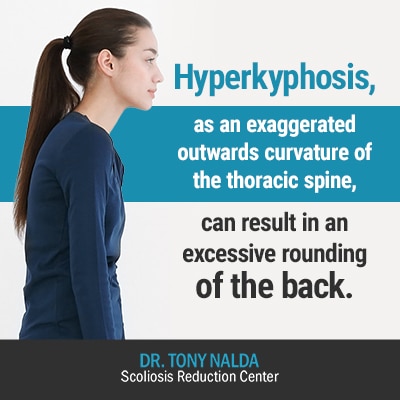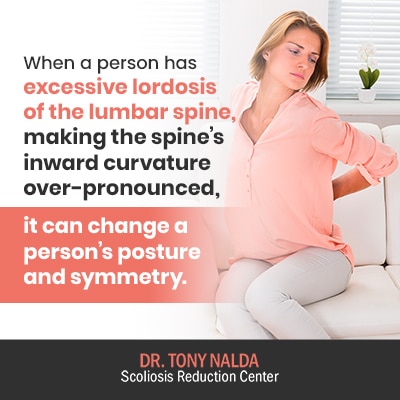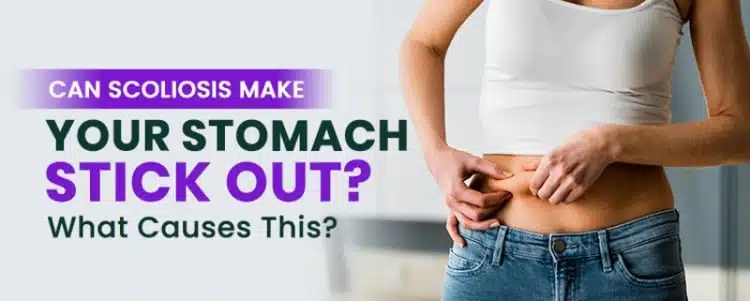The spine’s natural curvatures give it added strength, flexibility, and facilitate its ability to evenly distribute mechanical stress throughout. There are numerous spinal conditions a person can develop such as scoliosis, hyperkyphosis and hyperlordosis. Just as the spine has different types of healthy curvatures, it can also develop a variety of unhealthy curves that change the body’s overall posture and symmetry.
It’s natural for people, especially those recently diagnosed with scoliosis, to wonder what types of bodily changes are coming. While scoliosis can cause many postural changes, a protruding stomach is more commonly associated with hyperlordosis: an exaggerated inward curve of the lumbar spine.
To better understand the effects that abnormal spinal curvatures can have on the body, let’s first take a look at the spine’s natural and healthy curvatures, and the roles they play in preserving the health and biomechanics of the spine.
The Role of the Spine’s Natural Curvatures
If you were to look at the human spine from the side, you would see that it has a soft ‘S’ shape. The spine helps us balance, maintain a straight and upright posture, facilitates our movement and flexibility, and also works in tandem with the brain to form the body’s central nervous system (CNS).
As the body’s communication network, the CNS plays a role in virtually every system at work within the body, so any condition that affects the spine has the potential to affect numerous areas of the body.
A healthy spine will have three main natural curvatures that characterize each of the three main spinal sections, when viewed from the side: cervical (neck), thoracic (middle and upper back), lumbar (lower back).
There are two different types of spinal curvatures: kyphosis and lordosis. ‘Kyphosis’ refers to curvatures that bend outwards, away from the body’s center, while ‘lordosis’ refers to natural curvatures that bend inwards, towards the body’s center.
The thoracic spine’s curvature is kyphotic, while the cervical and lumbar spinal regions feature lordotic curves. Now, if one of these curvature types becomes excessive, this is known as ‘hyperkyphosis’, or ‘hyperlordosis’.
Hyperkyphosis

Hyperkyphosis, as an exaggerated outwards curvature of the thoracic spine, can result in an excessive rounding of the back. The condition can affect any age, but it is most commonly found in older women.
Age-related hyperkyphosis is often related to weak vertebrae (bones of the spine) that leads to them being compressed or cracking. Infants and teens can also develop hyperkyphosis due to a malformed bone in the spine, or wedging of the vertebrae.
When the exaggerated kyphosis is mild, it causes few noticeable issues; severe hyperkyphosis, however, is known to cause pain and postural changes.
Hyperkyphosis treatment will vary based on the patient’s age and the condition’s cause and severity. In mild forms, the condition might not produce any noticeable signs or symptoms, but more severe forms can cause back pain and stiffness, in addition to the abnormally-curved spine.
Hyperkyphosis Causes
The individual bones that make up the spine are called ‘vertebrae’ and are somewhat cylindrical in shape. These vertebrae are stacked on top of one another and are separated by intervertebral discs.
Hyperkyphosis occurs when the thoracic spine’s vertebrae become more wedge-shaped, impairing the spine’s ability to stay aligned and maintain its natural curves. These wedge-shaped abnormal vertebrae can have a number of causes:
Fractures: compression fractures are broken or crushed vertebrae.
Osteoporosis: most common in older women, osteoporosis is a bone-thinning disorder that results in weakened vertebrae.
Disc Degeneration: the soft malleable discs cushion the vertebrae and help maintain the spine’s flexibility and healthy curvatures. When the intervertebral discs start to erode, either due to age or the cumulative effect of certain lifestyle choices, the spine can no longer support its natural alignment and healthy curvatures
Scheuermann’s disease: also known as ‘Scheuermann’s kyphosis’, this disease most often starts with the growth spurt prior to puberty, and boys are more commonly affected than girls.
Cancer/cancer treatment: cancer in the spine can weaken the vertebrae and make them more susceptible to compression fractures. Tumours pressing against the spine can also push it out of alignment, and common cancer treatments like chemotherapy and radiation can also weaken the bones of the spine.
Birth defects: spinal bones that are malformed in utero can also lead to hyperkyphosis.
Syndromes: when children have hyperkyphosis, it can be associated with the presence of certain syndromes such as Ehlers-Danlos syndrome and Marfan syndrome.
Now, as mentioned before, there are various severity levels of hyperkyphosis with mild forms producing little or no noticeable signs and symptoms; conversely, severe hyperkyphosis can cause back pain and stiffness, and potential complications include breathing problems, digestive problems, and limited physical functions related to weakened back muscles.
Now that we have explored what happens when the spine’s natural kyphosis is lost, let’s take a look at what happens when the spine’s natural lordosis is compromised.
Hyperlordosis
Although the spine is naturally curved, too much of a curve can also cause problems, as is the case with hyperlordosis when the lower back’s inward curvature is exaggerated.
While hyperlordosis most commonly affects the lumbar spine, it can also affect the cervical spine.
Hyperlordosis can occur at any age, but it’s less common in children, and depending on its cause, it can be a reversible condition, if treated. Hyperlordosis is also known as ‘swayback’, and the postural changes caused by it can make the stomach protrude excessively.
Hyperlordosis Causes
Before we move on to discussing the symptoms of hyperlordosis, let’s first explore some of the condition’s most common causes:
Bad posture: chronic bad posture is one of the most common causes of hyperlordosis, which is why the condition can be reversible.
People who spend a lot of time sitting are more likely to develop hyperlordosis; when in a seated position, the muscles of the lumbar spine are excessively tightened as they attempt to stabilize and support the spine. Over time, this can pull the spine out of alignment and lead to an excessive curvature of the lower back.
Obesity: when a person is carrying excess weight in the abdomen and buttocks, this places extra strain on the lower back, which can lead to the lumbar spine bending unnaturally.
Weak core muscles: a person’s core muscles are located closely to the spine and play a role in supporting and stabilizing it. When a person’s core muscles are weak, it’s that much harder for the spine to maintain its healthy and natural curvatures.
Sedentary lifestyle: in addition to contributing to obesity, living a sedentary lifestyle without regular exercise and movement weakens the core muscles surrounding the trunk and pelvis. These weak muscles are less capable of supporting the spinal column’s alignment and natural curvatures.
The very design of the spine is about facilitating movement, and it’s through movement that the spine’s intervertebral discs are replenished and hydrated. When there is a lack of exercise and movement, this lifestyle is contrary to the spine’s design and negatively impacts its overall health.
Spinal conditions: in some cases, hyperlordosis is caused by another underlying spinal condition such as hyperkyphosis, spondylolisthesis, and discitis.
When the spine loses one or more of its healthy curvatures, the body responds by putting in compensatory curves in the opposite direction. This is done in an attempt to stabilize the spine. When hyperkyphosis is present, the opposite, hyperlordosis, can develop out of a compensatory effect.
Spondylolisthesis is a spinal condition known to cause lower back pain. When a vertebra slips out of place onto the vertebra below, causing excess pressure on the lower vertebra, this is spondylolisthesis, and this can cause the spine to become misaligned and lose its natural curvatures.
Discitis is a condition characterized by inflammation that develops between the spine’s intervertebral discs. When the intervertebral disc spaces experience swelling, this puts excess pressure on the discs, leaning to pain and spinal misalignment.
Hyperlordosis Symptoms
Again, condition severity always plays a role in determining how subtle or overt related symptoms can be.
One of the most common symptoms of hyperlordosis is muscle tightening and stiffness in the lower back. It can also damage the lumbar region’s soft tissue and spine.
Lower back pain is a common complaint of people with hyperlordosis, which can range from mild to severe and is known to worsen with movement.
A person with hyperlordosis can experience an abnormally curved spine, also known as ‘swayback’, due to the exaggerated inward curvature of the lumbar spine.
Swayback

When a person has excessive lordosis of the lumbar spine, making the spine’s inward curvature over-pronounced, it can change a person’s posture and symmetry.
Particularly when viewed from the side, the swayback appearance can be quite prominent with the buttocks protruding more at the back and the abdomen being thrust forward, giving the appearance of the stomach sticking out.
As mentioned earlier, hyperlordosis is often a reversible condition. While this will depend on the condition’s cause, when the most common causes of bad posture and lifestyle choices are to blame, these can be corrected.
Once related bad lifestyle habits are replaced with healthy ones, with the help of some chiropractic care and core-strengthening exercise, the natural lordosis of the lumbar spine can be restored.
Conclusion
So can scoliosis make your stomach stick out? As mentioned earlier, there are numerous spinal conditions a person can develop. Scoliosis, kyphosis, and lordosis are spinal conditions characterized by abnormal spinal curvatures. While scoliosis is associated with many postural changes that involve giving the body an overall asymmetrical appearance, a protruding stomach is more characteristic of another related spinal condition: hyperlordosis.
Scoliosis can cause a whole host of postural changes that give the body an unnatural lean to one side, resulting in the contortion of muscles, organs, and the stomach; however, a protruding stomach is more commonly associated with hyperlordosis than scoliosis.
While scoliosis does have the potential to cause enough body asymmetry to make the abdomen appear more prominent, this is more likely to occur in severe and extreme cases; the more common postural changes associated with scoliosis are related to an overall asymmetry such as uneven shoulders, shoulder blades, hips, a rib arch, and a lean to one side.
While hyperlordosis can also affect the cervical spine, it most commonly involves the lumbar spine. When a person loses the natural lordosis (inward curvature) of their lower back, the excessive inward curvature can cause stiff and tight muscles in the lower back.
Common hyperlordosis symptoms include lower back pain, difficulty with movement, a buttocks that protrudes more at the back and a stomach that protrudes more at the front. When looking at the body from the side, these tendencies are the most noticeable.
Fortunately, as the most common causes of hyperlordosis involve lifestyle choices such as not maintaining a healthy weight, being inactive, and not practicing good posture, with some hard work and chiropractic care, the condition can be improved upon as more positive habits are established.





